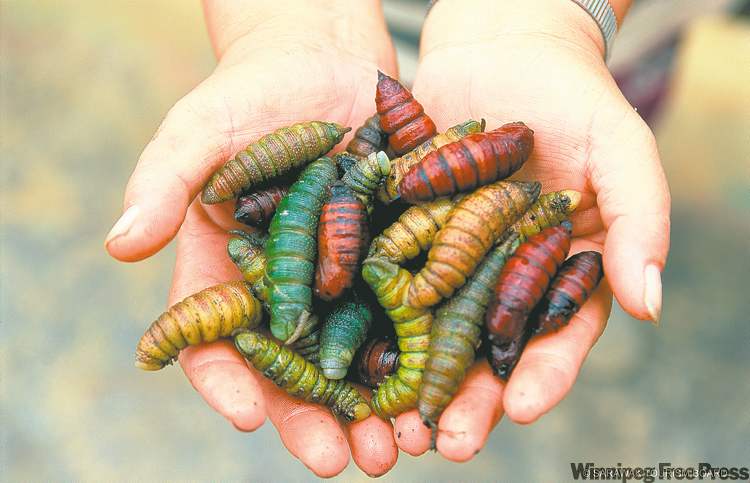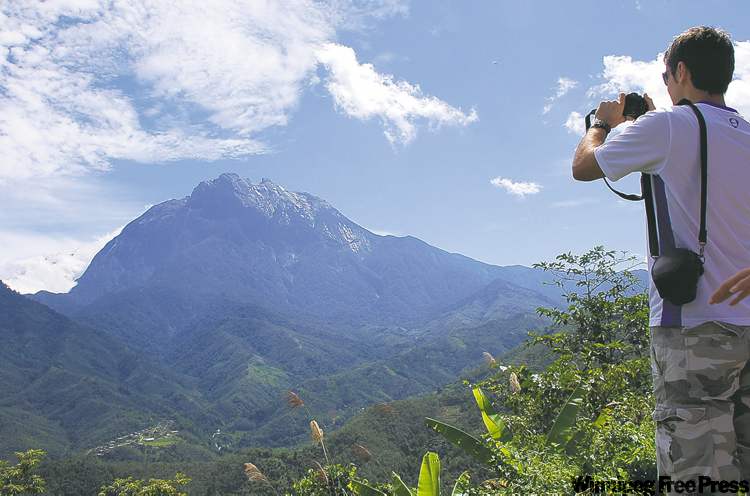Devouring Borneo
Country has history, nature and great food
Advertisement
Read this article for free:
or
Already have an account? Log in here »
To continue reading, please subscribe:
Monthly Digital Subscription
$0 for the first 4 weeks*
- Enjoy unlimited reading on winnipegfreepress.com
- Read the E-Edition, our digital replica newspaper
- Access News Break, our award-winning app
- Play interactive puzzles
*No charge for 4 weeks then price increases to the regular rate of $19.00 plus GST every four weeks. Offer available to new and qualified returning subscribers only. Cancel any time.
Monthly Digital Subscription
$4.75/week*
- Enjoy unlimited reading on winnipegfreepress.com
- Read the E-Edition, our digital replica newspaper
- Access News Break, our award-winning app
- Play interactive puzzles
*Billed as $19 plus GST every four weeks. Cancel any time.
To continue reading, please subscribe:
Add Free Press access to your Brandon Sun subscription for only an additional
$1 for the first 4 weeks*
*Your next subscription payment will increase by $1.00 and you will be charged $16.99 plus GST for four weeks. After four weeks, your payment will increase to $23.99 plus GST every four weeks.
Read unlimited articles for free today:
or
Already have an account? Log in here »
Hey there, time traveller!
This article was published 23/10/2010 (5494 days ago), so information in it may no longer be current.
KUCHING, Sarawak, on the Island of Borneo — The roof of a multi-storey parking lot is not the first place you’d expect to find some of the best food in town, but like much in Kuching, Top Spot comes as a pleasant surprise.
It’s loud, lively, colourful and, in the balmy night air that always seems to bless this place, an exceptional venue for people-watching and getting a sense of the exotic.
Top Spot is a sort of co-operative of seafood vendors who share the open-air space — there’s a ceiling but no walls. They compete vigorously for each customer, or group of customers, as they walk in, pointing excitedly at their employer’s neon sign.

It’s respectful hustle. Once the customer has chosen, the losers back away and move on to the next target.
Some customers have their favourite spot. Others, typically visitors without local knowledge, are swayed by the hawkers, but if there are major differences in the food quality or quantity, it isn’t obvious.
Locals will tell you that one vendor is better than the other, but I ate there three times and couldn’t detect any significant difference. On each occasion, the food was perfectly cooked and remarkably inexpensive — spend more than $5 or $6 (not including a local Tiger beer) and you’re probably overeating.
Each vendor displays an exotic array of fish and shellfish. The diner buys by weight and sits while it’s cooked and served. There is no ownership over the chairs and tables, most of which are large, round and occupied by extended local families.
Where locals go to eat, tourists would be wise to follow — especially when there is lots of choice in town.
Food is one of Sarawak’s major selling points and eating is one of its favourite pastimes, but beyond the belly there is a whole exotic world for visitors to explore. It’s fair to say that Sarawak is not on the Canadian tourist radar, but for those with a flair for the exotic it should be. It’s a long, relatively expensive journey to the other side of the world, but once you’ve made that leap, there’s a wonderful world of nature, history and culture to explore — and once there, you can do it comfortably on a relatively tight budget.
Kuching, the state capital, is a good place to land. It is the largest state in Malaysia and sits on the island of Borneo.
Kuching has a rich history.
Within a short distance of the city centre, there are crocodiles, orangutans, proboscis monkeys and relatively easy access to the rainforest where the proboscises swing from branch to branch — if you’re lucky enough to see them.
It’s hot, invariably humid and if you go at the wrong time of year, it rains furiously. But weather patterns have become unpredictable. The rainy season isn’t what it used to be.
Kuching means cat in Malay, which is why the city appears to have a cat fetish.
It has massive cat statues in and around its city centre and even has its own cat museum. This kitty kitsch has successfully branded the city, but it is neither representative of Kuching — an orangutan or monkey might be more appropriate — nor, say linguistic experts, is it an accurate interpretation of the city’s name.
More likely, they say, it derives from the Mandarin kochin, which means harbour, or it is named after the lychee-type fruit mata kuching (cat’s eye). Either way, the cats are there to stay.

Kuching is blessed with a rich colonial past that was sporadically nasty while it was being written, but has left a legacy that the city’s smart tourism marketers use to its fullest.
During the early 19th century, Sarawak was a Malay principality ruled by the Sultan of Brunei and, give or take bouts of headhunting in the interior — plastic skulls are plentiful in souvenir shops — was generally peaceful. That changed when the sultan appointed an unpopular governor and a guerrilla war ensued that continued until 1839, when a young and wealthy Englishman named James Brooke arrived with his own private army and quashed the rebellion.
The grateful sultan made Brooke the Rajah of Sarawak and, in the British colonial tradition, Brooke and his descendants put an indelible stamp on Sarawak and its capital. After the Second World War and an ugly period of Japanese occupation, Sarawak worked its way toward independence and joined Malaya in 1963 to form the new nation of Malaysia.
While Kuching’s myriad of museums hold many stories of this colonial era, it’s the nature and culture of Sarawak that are its greatest tourist resources — along with the people who overall are laid-back, but still curious enough about westerners to make interaction fun. Short drives from the city are two of the biggest attractions: The Sarawak Cultural Village and the Semenggoh Wildlife Centre, where you get close with orangutans.
At the Cultural Village they boast that you can See Sarawak in Half a Day which means you can taste the culture of the entire state in this exceptionally well structured live museum.
There are buildings, displays and demonstrations representing all of Sarawak’s ethnic groups — Bidayuh, Iban and Orang Ulu longhouses, a Penan jungle settlement, a Melanau tall house, a Malay townhouse and a Chinese farm house. All are staffed by people in traditional costume and they eagerly demonstrate local crafts and pose for the tourist cameras.
The Cultural Village also hosts the increasingly popular Rainforest World Music Festival, happening this year from July 9 to 11.
A note here: It pays huge dividends to prepare for a visit to Sarawak by reading up on the place. Its political and cultural complexities aside, just getting a sense of the history, its possibilities and its people is worth the time. And if you’re flying from Canada, there is more than enough time.
At the Semenggoh Wildlife Centre, a 150-kilogram orangutan named Ritchie reigns supreme.
The centre’s orangutans gather for two feedings a day; tourists typically time their visits to coincide with one of these.
The environment is open and natural and graphic pictures at the entrance show that while they might look cute, getting too close is not a good idea. There’s a viewing area, but it isn’t enclosed and the wardens spend much of their time fretting over the proximity of orangutan to human visitor.
Ritchie is a character — a poseur — and walking and climbing proof that humans and orangutans share more than 90 per cent of the same DNA.

Ritchie’s demeanour is serious bordering on sensitive,’ says a notice, warning that he dislikes camera tripods, crying babies, teasing, umbrellas and bright clothing. He looks proud and preening, but he doesn’t like looking at his image in a mirror. When he’s been seriously upset he has been known to attempt a single-handed demolition of wooden buildings that dot the place.
But he loves surrounding himself with females and, like most of his human cousins in these parts, loves eating. Orangutans spend 60 per cent of their lives hunting for and consuming food. For the much-photographed feeding times, their diet includes sweet potato, bananas, papayas, sugar cane and hard-boiled eggs.
A 40-minute bus ride out of Kuching brings you to the edge of Bako National Park, which covers the northern tip of the Muara Peninsula and is set against a stunning backdrop of ocean and misshaped rocky outcrops emerging from the water.
The bus drops you at a jetty and a spectacular half-hour boat ride takes you the rest of the way.
Bako is also a Borneo sampler in that it contains every type of vegetation found on the island and sightings of wildlife are almost guaranteed.
I was just 20 minutes along a rainforest path when I was able to watch the proboscis monkeys flitting from tree to tree high on the forest canopy and the more visible long-tailed macaque monkeys which, visitors are warned, are born thieves. The wild boar have faces to behold — ones that only a mother could love.
Bako offers simple overnight accommodation for about $30 and trails for all levels of adventurous spirit. From the trip out by boat and back, and all in between, it is a memorable experience.
But back to Kuching.
The city’s riverfront is the focal point. It has a two-kilometre-long pedestrian path close to the city’s few major hotels and is the place to stroll, run or just sit and think.
You can take a sanpan across the river for pennies and visit the striking new $100-million state legislature building, which opened last July.
It’s called the Dun — Dewan Undangan Negeri, which is Malay for — you guessed it — State Legislature Assembly.
The glass-and-metal roof looks like a massive golden Easter bonnet and, architecturally, it has a mixed look of the ancient and modern. Investigate more deeply and you’ll discover this nine-storey monolith is an architectural interpretation of Sarawak’s deep culture.

Inside, it’s a technological wonder with all the latest bells and whistles. The views from the ninth floor are spectacular.
And if you take the sanpan, watch the skill with which the barefooted boatmen ride the broiling currents as they manoeuvre from one side of the river to another.
Aside from its own natural and man-made assets, Kuching has the distinct advantage of being the gateway to other parts of Borneo and other parts of the region — Singapore, Hong Kong, Kuala Lumpur and so on.
The airport is served by several airlines but anyone travelling from Canada to Sarawak should eventually link with Malaysia Airlines, which makes even economy class travel a decent experience. Its reputation as an airline that treats all customers with an equal degree of grace is well earned. They make you feel welcome rather than tolerated.
Like armies, tourists march on their bellies. It’s a rare vacation or travel experience that is agreeable without good food at reasonable prices.
So we’re back where we started.
Go to the Top Spot and dig in.
— Postmedia News

